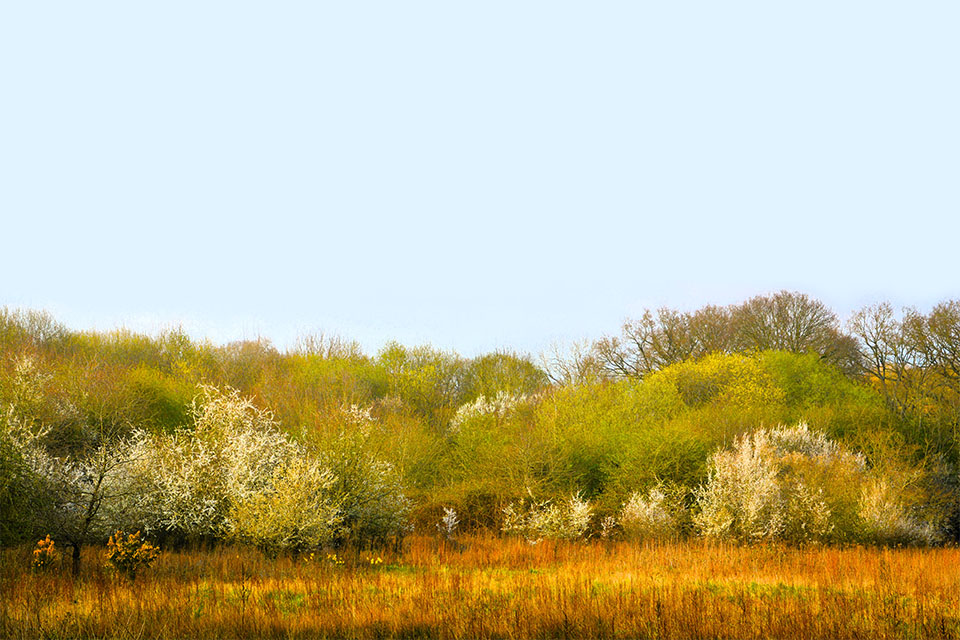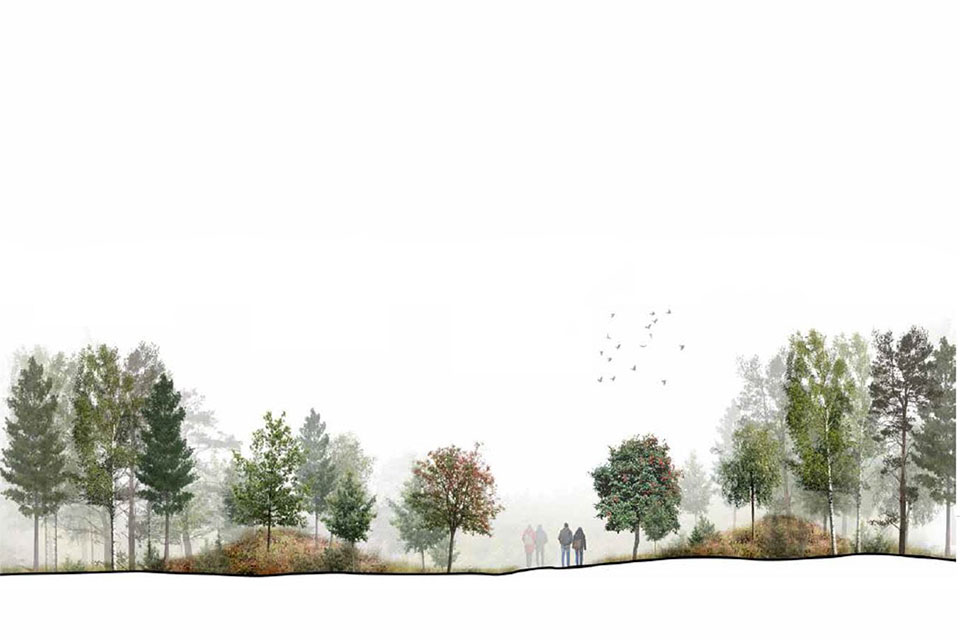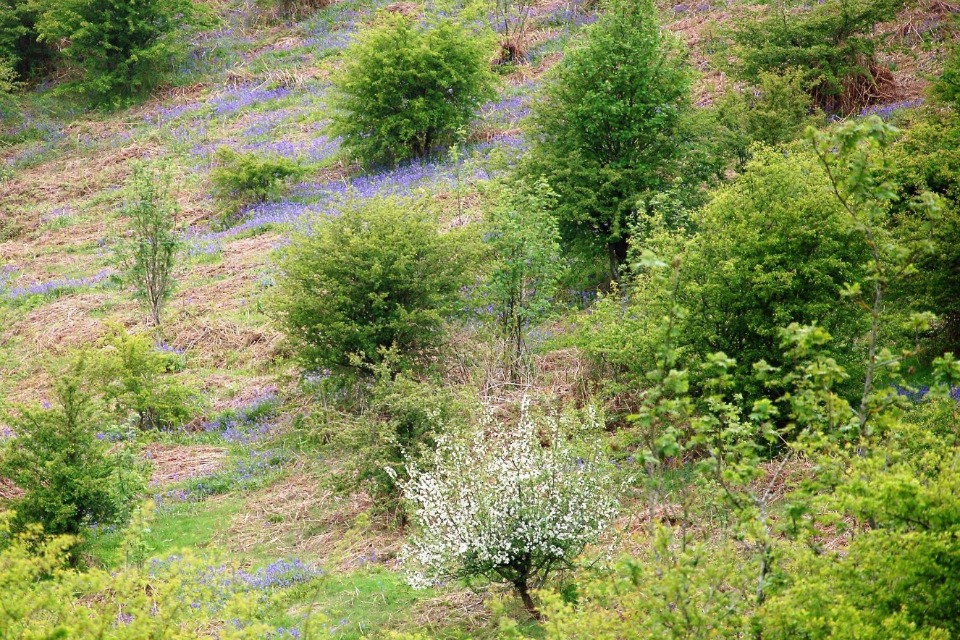Edge design for woodland integration, resilience and biodiversity
Learn how good edge design can create woodlands that fit well into the landscape, benefit management and resilience, enrich biodiversity and provide inspiring places for people.
Applies to England
An introduction to woodland edge
Woodland edge is the transitional area between a forest and the open landscape. It encompasses both internal space, such as rides, tracks and glades, and external spaces, including road verges, transitions with other woodland, farmland, moorland and the urban fringe.

A woodland edge showing structural, ecological and visual diversity. Copyright: Richard Hellier.
Woodland edge design is crucial for integrating and connecting new woodlands with a site and its landscape context. It considers the incorporation and relationship of new woodland compartments with ready-made ‘edge’ networks, including hedges and scrub, open grown trees, natural colonisation and linear features, such as shaws. It supports landscape restoration, nature recovery, woodland resilience, and provides diverse places for people.
This woodland zone is valuable for resilience, ecological and structural diversity and provides natural beauty at a human scale.
Over the last century, England has lost much of its edge habitat due to hedgerow removal, reduced woodland management (especially coppicing), and the use of more mechanised and intensive land management.
Unlike typical woodland planting, edges have irregular patterns, mimicking natural processes. The density of trees and scrubs decreases the further away from closed canopy woodland. It is primarily composed of light demanding, pioneering and native species, such as hawthorn and blackthorn with shrubby willow and birch. Usually in clusters and clumps rather than evenly spaced.
The woodland edge can include a mix of:
- a patchwork of open ground habitats
- single and clusters of forest scale trees such as oak
- single, groups and thickets of a variety of small trees and shrubs

An example of various edge characters and types including natural colonisation of pasture. This can be used as a design analogue for new woodland. Crown copyright.
Benefits of woodland edge
Well designed and detailed edge contributes to UK Forestry Standard (UKFS) compliance. It reinforces spirit of place, creates unity, diversity and provides a resilient woodland, as well as many functional benefits, such as:
-
Biodiversity: good edge is essential for woodland wildlife, with many specialised species adapted to its transitional, dense and varied habitat.
-
Resilience: the structural and ecological diversity of edge supports the natural functioning of woodland.
-
People and access: well-designed edges create attractive fringes to high canopy woodland. This includes much seasonal interest at eye level, bird song richness, diverse insect populations and flowering plants, especially when facing south in full sun.
-
Operational: edge is important for managing deer populations, protecting against windthrow, buffering wildfires and creating sheltered microclimates over the lifetime of the wood.
-
Landscape integration: edges are fundamental to good integration of woodland into the surrounding landscape. This applies in both enclosed and open landscapes creating unity and reflecting local distinctiveness.
Woodland edge in large-scale, upland landscapes, such as conifer schemes can include carefully sited, broadleaf woodland, scrub and natural colonisation. This needs to be at a scale that reflects the landscape sensitivity, scheme prominence and size of the new woodland.

The outer fringes of this example shows higher density, closed canopy woodland, with forest scale species. This woodland type is set well back from an existing desire line allowing good light conditions for the internal edge zone to thrive. This planting will be at lower density and an open mosaic, with small edge trees and shrubs planted in varied clumps. Typical species should reflect local character but usually include hawthorn, blackthorn, hazel, grey willow, rowan and birch. Crown copyright.
This woodland edge fringing the ride will require periodic management to maintain diversity, good surface conditions and wildlife habitat.
Designing woodland edge
You should consider edge at the start of your woodland design in both landscape context analysis and site appraisal plans.
Map existing areas of edge, including hedgerows, scrub and natural colonisation. Ideally these will be joined throughout the woodland with planting to create a diverse edge mosaic.
Edge may be dense and compact in lowland areas with arable farming, or expansive in semi-natural environments like moorland or heathland. Chalk and limestone areas have a distinctive community of trees and shrubs that are suitable for woodland edges in these landscapes.
With careful design and planning, existing hedgerows, tree lines and areas of natural colonisation can significantly contribute to new woodland. Mapping this at site appraisal stage means these edge areas can be positively integrated into new woodland with additional planting.
Edge character will vary depending on the site, landscape context and local distinctiveness. This will contribute to ecological and visual diversity.
Consideration of the scale of the open space buffer should take account of the woodland extension over time.
Edge habitats require high light levels throughout their life cycle. You can meet this need through management but also by ensuring adequate scale of adjoining space is designed into the woodland.
Important factors in edge design:
-
Optimum edge needs good light conditions and adequate open space for healthy development. It requires careful spatial design and consideration of management inputs over time.
-
Natural edge shape is graduated with lower planting density and smaller species furthest away from closed canopy woodland.
-
Edge can be a mix of new planting, existing trees and shrubs, natural colonisation and regeneration.
-
Edge as a habitat mosaic and landscape type encompasses rocky outcrops, the fringes of watercourses and water bodies, glades and open habitats, as well as adjoining access and operational routes within the woodland.

An example of edge with a south-facing aspect showing structural, ecological and visual diversity, established through natural colonisation. Copyright: Richard Hellier.
Woodland edge design principles
Consider all existing edge in the landscape context. Map edge using these design principles in the landscape character appraisal:
-
Integrate valuable, existing edge features within new woodland designs. This brings maturity, resilience and structure to new woodland, creating unity and conserving local distinctiveness and character.
-
Design new edge treatments to reflect local landscape and associations, using natural regeneration where appropriate. Being informed by the landscape context, new planting will be more resilient and have a good landscape fit.
-
Consider the light demanding needs of edge and allow enough scale of space to avoid overshading over time. Take into account the margins of forest planting stands grow laterally as well as vertically.
-
Recognise the value of south-facing edges, where full light creates ideal conditions for rich structural, ecological, and visual diversity. These aspects offer the best opportunity to deliver multiple benefits, so design and plan with light and aspect in mind.
-
Edge is generally the ‘naturalistic’ outer zone to forest scale planting and should be designed to reflect natural patterns and landform. This can be done by using a local analogue, making it easier to reflect authentic species proportions, mixes, and distributions.
-
Design ‘edge and open space’ together as a connected, unifying framework within and around the core woodland. This important woodland zone will link existing retained features and areas to be left unplanted with the wider landscape context.
-
Factor in an appropriate edge management regime during the design and planning stages.

An example of edge at a landscape scale with a mix of trees and shrubs of different sizes on a downland hillside. Copyright: Richard Hellier.
If you’re developing your own woodland design plan, find out more about landscape character appraisals and see examples.
Creating woodland edge
Although edge planting is the most common method of establishing edge, natural regeneration and colonisation can also be effective in many situations. Sometimes, a blend of both techniques is appropriate, especially if you want to create greater diversity.
You will need to plant a mixture of trees and shrubs of different heights that reflect the landscape context. They should be laid out and grouped together in different ways throughout a diverse edge zone.

This edge at Peak District National Park embodies natural colonisation and shows its structural, ecological and visual patterns. This will be with a selection of sub-dominants and occasional species such as whitebeam, wild service tree, rowan and crab apple. Lower density allows good thicket to develop. Crown copyright.
Having one species dominating the area, such as hawthorn, reflects a natural pattern. Rowan and many chalk-loving shrubs can be used in small quantities.
You should encourage species that are already present and consider if you need to enhance the edge using blended or enrichment planting.
Managing woodland edge
Woodland edge requires management over time to retain dense thickets and varying degrees of openness.
At the design stage you will have considered the scale of open space as the woodland develops and how to manage this.
Consider whether coppicing, thinning, cutting, or light grazing are necessary, or if a non-intervention approach with natural regeneration is more suitable to ensure an open structure.
Edge is usually a semi-permanent woodland element, both external and internal, creating a network of compartments and corridors alongside and as part of a ride and open space system. This applies to all types of woodland management objectives, whether for production, recreation, or conservation purposes.
Light and open space are essential for edge to thrive, look good and function. Together, the edge and open space networks create a diverse and vital woodland component connecting all unplanted elements within woodland.
Read more about sustainable woodland management and what regulations you need to follow on managing and maintaining woodlands.
UK Forestry Standard and edge design
All woodland design in England must follow the requirements of the UK Forestry Standard (UKFS).
Whilst using this guide, you must consider the UKFS General Forestry Practice note 23 on forest planning, which states that:
new forests must be located and designed to maintain or enhance the visual, cultural, and ecological value and character of the landscape.
When applying edge design to woodlands, focus on the following UKFS forest and landscape requirements:
-
Landscape context (1): forests should be designed and managed to take account of the landscape context, considering the sensitivity, character and distinctiveness of the local area in line with the European Landscape Convention.
-
Landscape context (2): forests should be designed and managed in consultation with statutory bodies to take account of landscape designations, designed landscapes, historic landscapes and relevant policies and strategies.
-
Forest design principles (3): forest design principles, informed by the landscape context, should be applied to ensure landscape and visual aspects are appropriately addressed.
Further information
This introduction to edge design is part of a series of good practice guides to support landscape and woodland design guidance. You should read it along with landscape and woodland design for woodland creation guidance.
For further information or questions about this page, email: landscape@forestrycommission.gov.uk.
Read more about woodland design and creation: